From AI to XR and beyond, the future is here. But that doesn’t mean robots have pushed human translators out of the picture. Instead, with cutting-edge technological innovations hitting the news every single day, now is the perfect time to ask: how have human translation services evolved with the integration of new technologies?
Sophisticated tools for post-editing
For over forty years, human post-editing has been the gold standard for combining human translation with the increasingly high-tech field of machine translation (MT). Looking back to the Georgetown-IBM experiment in 1954, an early and influential machine translation demo, we find an algorithm that was rudimentary and slow, which lacked the ability to analyze sentence structure, and which contained only 250 vocabulary items in its lexicon. Today, in contrast, there are extremely sophisticated tools to aid human translators in their work.
Translators now benefit from cutting-edge CAT tools (computer-assisted translation tools) and translation management systems that leverage advances in software to help translators maximize their efficiency. These tools can handle the bulk work of translating massive projects, maintaining enormous electronic dictionaries, managing translation projects, and more, which in turn frees up translators’ time to polish machine output to a high-quality level of accuracy, cultural relevancy, and organic style. Plus, the plethora of CATTs available on the market means that the best language service providers will now become experts on advising clients about which tools are best suited for which project.
Artificial Intelligence and deep learning
Artificial intelligence (AI) is the hot topic of the tech world, and there’s no denying its impact on the translation industry. In particular, neural machine translation (NMT) currently uses deep learning algorithms to process extremely large sets of language data, and there’s an ongoing drive to incorporate generative AI into NMT processes.
However, how will this affect human translation services? Generative AI isn’t perfect, so human translators will still be necessary for editing and calibrating any translations produced by machine. Some predict that the future of language translation will be a harmonious balance in which human translators work with machine systems to produce ideal results.
Advances in translation technology
Don’t forget about the updates in the actual, physical technology used to support human translators. The past several years have seen vast technological leaps in the wearability, movability, and accessibility of translation equipment, videoconferencing platforms, and other apparatuses for human translators and interpreters. Apps and mobile smart devices, for instance, can now help connect clients with live interpreters in real time, all over the world.
The rise in technological innovation has also generated brand-new and growing areas of demand for human translation. For example, as more organizations explore the use of augmented reality (AR), virtual reality (VR), and remote technology to engage multilingual consumers—the White House itself just announced a new virtual tour that offers both audio captions and Spanish translation options—human translators must be involved to ensure translated elements meet federal accessibility standards.
So, while we may not have a crystal ball to predict the future, we can definitely predict that professional human translation services will remain a crucial part of the language industry.






